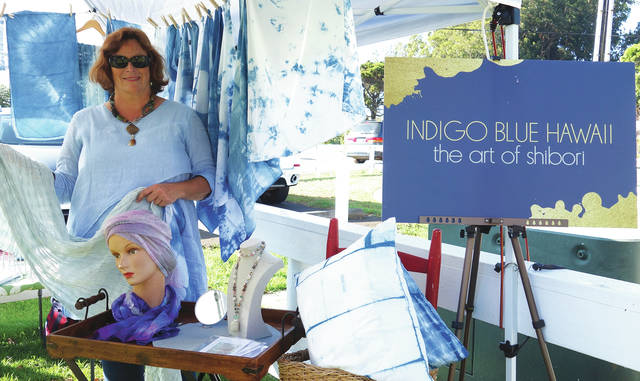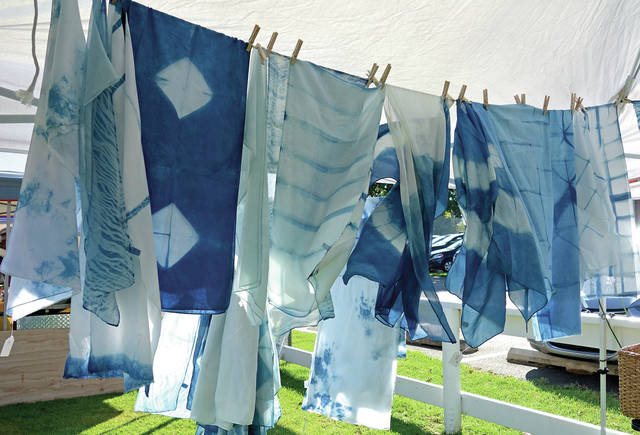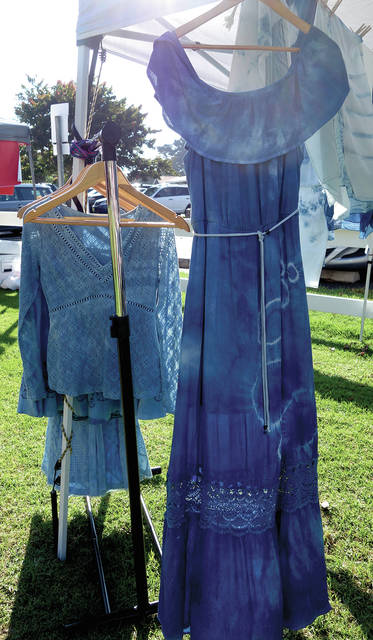WAIMEA — Just over a month ago, Helen Nahoopii unleashed her artistic talents in a new booth at Waimea Town Market: Indigo Blue Hawaii. ADVERTISING WAIMEA — Just over a month ago, Helen Nahoopii unleashed her artistic talents in a
WAIMEA — Just over a month ago, Helen Nahoopii unleashed her artistic talents in a new booth at Waimea Town Market: Indigo Blue Hawaii.
Her company provides quality, affordable home goods and clothing made from natural dyes on 100 percent cotton, silk, hemp or linen.
“Thrift is key; 90 percent of our product is dual purpose,” Nahoopii said.
Growing up with her family on the remote shores of East Hawaii in the village of Pohoiki, the American concept of cash and carry — where everything purchased came from large manufacturers abroad — was their reality in the late 1960s.
“Being in a large Hawaiian family provided insight into the idea of living simply, primarily because money was scarce,” Nahoopii said. “Back then, my great grandmother, a pure Hawaiian, lived in a simple plantation style shed in the village of Hau’ula on Oahu.”
She continued, “My great grandmother wore handmade simple muumuus. She would read aloud to us from English novels gifted to her from a teacher friend at Kamehameha Schools in Honolulu. She was thrifty, but more importantly she lived with dignity, grace and ease. I found great value in her presence; to live simply.”
Many of her artistic influences came during her childhood and while in school. As a young girl, Nahoopii was influenced by the book, “The Unknown Craftsman.”
“It talked about the people in the countryside of Japan who couldn’t afford the finer things of the city folk,” she said. “They would hand make everything that they used and would do it with thrift in mind, but with it also being intentionally multi-purpose. It would have to have three elements: it would have to not only be beautiful but also functional and be of thrift and value. That has always stuck with me.”
Nahoopii started Indigo Blue Hawaii about six months ago.
“I realized that I wanted a career shift and change from when I did professionally,” she said. “I have been a marketing director for nonprofits and I did fund development and strategic planning for small business for over 25 years.”
The items found at her booth are made by twisting and dying 100 percent natural fibers. Shibori is a Japanese dye technique she uses dating back to the 8th century. On the fabric patterns and shapes are created using resist methods: round, rectangular, square and triangle patterns infused into the fabric of choice. She also utilizes a string wrapping method which creates almost like an ocean or watery pattern called rashi that’s common with squares and circles in linear patterns created with pieces of wood.
“Japanese commoners in the countryside would handcraft their household goods and personal adornment as a matter of thrift. Everything made held a purpose, was functional and embodied a simplistic beauty,” Nahoopii said. “For my dye I use a natural indigo blue. It has an indigo, iron and calcium combination that’s the traditional method the Japanese used in the countryside of Japan. My indigo color is kind of gray blue that’s a pretty smoky blue that’s very different then you find maybe over in Hilo or Kona.”
Nahoopii first learned about shibori in college.
“I studied Oriental Art History and eventually earned a BA in liberal arts from The Evergreen State College in Washington. I was working with an instructor who gave me the basics about shibori and I continued to study with a Zen master,” Nahoopii said. “I think I was always drawn to the idea of the Japanese a sense of design and simplicity.”
Her interest in fiber arts continued with weekend courses and workshops to learn fiber art methods. A return to Hawaii in 1994 led her to learn sumi-e, the Japanese art of monochromatic ink painting, with American zen master Paul Reps. She took other coursework over the years in shibori at Oregon College of Arts and Craft, and additional fiber art classes throughout the years.
“My passion was art. My professional living was to help others,” Nahoopii said.
All the while, she held a belief and a mission to live simply: to embrace the philosophy that best served her over a lifetime and to create art that others could afford and would serve a dual purpose.
“Today, I have returned to Hawaii and to pursue my passion with Indigo Blue Hawaii,” Nahoopii said. “The idea of the clothing line was to find clothes that were cotton linen or silk that could be recycled.”
The funds that come from selling her items go towards St. James church’s local food pantry. In addition to a clothing line, she sells her own scarves and noren — a Japanese a window screen — and furoshiki, a Japanese bath towel.
“Working in the medium of fiber taps into all of my senses: its tactile, it’s visually stimulating and it is three-dimensional,” Nahoopii said. “Doing the Japanese shibori method is serendipitous. Magic happens as I begin with a white surface only to then manipulate: either hand paint, then iron pleats, fold, bind and then hand dip into a vat of indigo that’s then exposed to air which oxygenates the fabric and turns it blue.”
The ultimate thrill she says is the end result.
“Since opening my booth, I’ve been very busy,” Nahoopii said. “Right now I making about 20 to 25 pieces a week. People have also been coming up and giving me things from their own shibori collections as gifts. It’s an opportunity to really meet people in our town as well as visitors from all over the world. Their appreciation for handmade things is so evident because it’s become so rare.”
Two Saturdays ago, she gifted one of her cotton creations to a local lady.
“She came back this week and gave me her collection of bon dance, such as the little rap that they wear when they’re dancing,” Nahoopii said. “The ladies wear them either around their head or a scarf around the neck. Each piece is a commemorative. The previous owner said she wanted this collection to go to someone that would appreciate the fabric of the hand-painted images, the printing and the history of these pieces.”
Opening a shop one day may be on the horizon.
“Someday I’d like to have a place in town here where people could just come in and paint their own fibers and learn the art and technique of shibori,” she said. “I look forward to having a studio and a place where I can display some of the vintage Japanese antiquities that I have been collecting over the years.”
Nahoopii believes everyone should be able to afford art. Her pieces start at $10 and go up to $60. She also offers workshops to teach the “Art of Shibori” and “Shibori to Dye For” parties.
Info: Call Indigo Blue Hawaii at 937-1705








